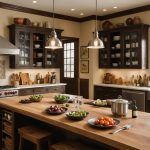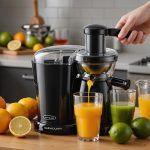Unlocking the Perfect Lobster Feast: Your Ultimate Guide to Choosing the Right Stock Pot Size
When it comes to preparing a decadent lobster feast, one of the most crucial elements is the stock pot. It’s not just about any stock pot; it’s about choosing the right size and quality to extract the fullest flavor from your lobster. Here’s a comprehensive guide to help you make the best choice for your culinary adventure.
Understanding the Importance of Stock Pots in Lobster Cooking
Before we dive into the specifics of choosing the right stock pot size, it’s essential to understand why stock pots are so vital in lobster cooking. A stock pot is more than just a vessel; it’s a key to unlocking the rich flavors and aromas of your lobster.
Also to see : How to Choose a Range Hood that is Both Powerful and Quiet?
“When we splurge on lobster, I gather the shells together and tuck them in a stock pot. The next day, or two months from then, we’ll feast on lobster bisque,” explains Dorothy Grover-Read from The New Vintage Kitchen. This approach highlights the value of using every part of the lobster to create a delicious and flavorful broth[1].
Determining the Right Stock Pot Size
Choosing the right stock pot size is a balance between ensuring you have enough room for all the ingredients and avoiding unnecessary bulk. Here are some key considerations:
Topic to read : Discover the Best Blade Material for Your Mandoline Slicer: Achieve Perfect Cuts Every Time!
For Lobster Bisque and Large Quantities
If you’re planning to make a large batch of lobster bisque or cook multiple lobsters at once, you’ll need a substantial stock pot. A 20-quart stock pot, like the Le Creuset Enameled-Steel Stock Pot, is ideal for such tasks. This size allows you to add all the necessary ingredients, including lobster shells, vegetables, and spices, without overcrowding the pot[2].
For Smaller Gatherings
For smaller gatherings or when cooking just a few lobster tails, a smaller stock pot might be more appropriate. A 10- to 15-quart stock pot can handle the job efficiently while taking up less storage space.
Key Features to Look For in a Stock Pot
When selecting a stock pot, several features can make a significant difference in your cooking experience.
Material
- Stainless Steel: Known for its durability and ease of cleaning, stainless steel is a popular choice. It distributes heat evenly and is resistant to scratches and corrosion.
- Cast Iron: Cast iron stock pots are excellent for retaining heat but can be heavier and require more maintenance.
- Enamel-Coated Steel: This material, as seen in Le Creuset cookware, combines the benefits of stainless steel with a durable, stain-resistant enamel finish that is easy to clean[2].
Size and Depth
- Ensure the stock pot is deep enough to allow for the simmering of ingredients without overflowing.
- A wider mouth makes it easier to add and remove ingredients.
Handles and Lid
- Look for stock pots with secure, comfortable handles that make it easy to lift and pour.
- A tight-fitting lid is crucial for retaining heat and moisture.
Practical Tips for Using Your Stock Pot
Here are some practical tips to get the most out of your stock pot when cooking lobster:
Preparing the Ingredients
- Save the Shells: When cooking lobster, save the shells and heads to make a rich and flavorful stock. This is especially true for lobster bisque[1].
- Add Aromatics: Include aromatics like onions, celery, and carrots to enhance the flavor of your stock.
- Use Herbs and Spices: Bay leaves, thyme, and paprika can add depth to your lobster stock.
Easy Steps to Make Lobster Stock
- Fill the Stock Pot: Add lobster shells, heads, and any other seafood or vegetable trimmings to the stock pot.
- Add Water and Spices: Cover the ingredients with water and add your chosen herbs and spices.
- Simmer: Bring the mixture to a boil, then reduce the heat and let it simmer for about 40 minutes to an hour.
- Strain and Store: Strain the stock and store it in the freezer for future use.
Detailed Recipe: Lobster Stock
Here’s a detailed recipe to make the perfect lobster stock:
Ingredients
- Lobster shells and heads
- 1 large onion, chopped
- 2 stalks of celery, chopped
- 2 carrots, chopped
- 1 fennel bulb, chopped
- 1 tablespoon Old Bay seasoning
- 1 tablespoon sweet paprika
- 2 bay leaves
- Salt and pepper to taste
- Any other desired spices (e.g., saffron, lemons)
Instructions
- Heat the Pan: In a large stock pot, heat a bit of oil over medium heat.
- Sauté Aromatics: Sauté the chopped onion, celery, and carrots until they start to soften.
- Add Ingredients: Add the lobster shells, heads, fennel bulb, Old Bay seasoning, sweet paprika, bay leaves, salt, and pepper.
- Cover with Water: Cover the ingredients with water and bring to a boil.
- Simmer: Reduce the heat and let it simmer for about 40 minutes to an hour.
- Strain and Store: Strain the stock and store it in the freezer for future use.
Table: Comparing Stock Pot Materials
| Material | Durability | Heat Distribution | Ease of Cleaning | Weight |
|---|---|---|---|---|
| Stainless Steel | High | Excellent | Easy | Light to Medium |
| Cast Iron | Very High | Excellent | Requires Seasoning | Heavy |
| Enamel-Coated Steel | High | Excellent | Easy | Medium |
List: What to Avoid in Your Lobster Stock
- Potato Peelings: Avoid using potato peelings due to the risk of solanine, which can cause stomach discomfort[1].
- Strong Flavors: Be cautious with strong flavors like beets and cabbage, as they can overpower the stock. Balance them out with other vegetables[1].
- Slimy or Moldy Ingredients: Never use ingredients that are slimy or have mold on them, as they can spoil the entire stock[1].
Choosing the right stock pot size and material is crucial for preparing the perfect lobster feast. Whether you’re making lobster bisque or simply cooking lobster tails, a well-chosen stock pot can enhance the flavor and ease of your cooking experience.
As Dorothy Grover-Read aptly puts it, “It doesn’t take long to create a routine of saving all those little scraps of veggies… Rather than dump whatever you have from a food prep into the trash, dump them in a container in the refrigerator or freezer until you have enough to make broth.” This mindset not only reduces waste but also adds a layer of depth to your cooking that store-bought broths can’t match[1].
So, the next time you’re planning a lobster feast, remember that the right stock pot is your key to unlocking a culinary masterpiece. Happy cooking








